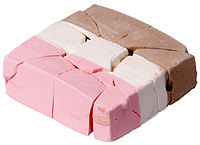
Photo from wikipedia
One of the main problems in the food industry is the formation of biofilms on food contact surfaces. These bacterial communities show high resistance against the commonly used disinfectants, which… Click to show full abstract
One of the main problems in the food industry is the formation of biofilms on food contact surfaces. These bacterial communities show high resistance against the commonly used disinfectants, which makes them difficult to eradicate causing economic losses and threatening the quality of the products and the health of consumers. Several studies have reported the use of atmospheric pressure plasma technologies to provide antibacterial properties to a wide range of materials through the deposition of coatings that either avoid the initial attachment of bacteria to the surface or kill the attached bacteria before the mature biofilm is formed. These technologies avoid the use of extreme pressures and temperatures during the deposition process, thus preserving the properties of the substrate, which makes them interesting for their potential application in the production of anti-biofilm food contact materials. This paper reviews different approaches that use atmospheric pressure plasma technologies to combat bacterial colonization and biofilm formation on materials of relevance for the food industry. Three types of approaches are identified and their suitability in the food industry is discussed.
Journal Title: Food and Bioprocess Technology
Year Published: 2019
Link to full text (if available)
Share on Social Media: Sign Up to like & get
recommendations!